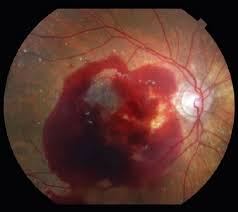
Faricimab, brand name Vabysmo, is a monoclonal antibody used for the treatment of neovascular age-related macular degeneration (nAMD) and diabetic macular edema (DME).
Faricimab is the first bispecific monoclonal antibody to target both vascular endothelial growth factor (VEGF)[1] and angiopoietin 2 (Ang-2).
Faricimab targeting these pathways stabilizes blood vessels in the retina.
It is given by intravitreal injection.
Humanized monoclonal antibody
VEGF-A, angiopoietin
Pregnancy category AU: D
Faricimab is indicated for treatment of neovascular age-related macular degeneration (nAMD) and diabetic macular edema (DME).
The most common adverse reaction reported in people receiving faricimab include conjunctival bleeding.
Contraindications to injection of faricimab include active infection in or around the eye, active inflammation in the eye (uveitis), and prior allergic reactions to receiving the drug.
There are no controlled studies of faricimab administration in pregnant women.
There is no information regarding faricimab accumulation in breast milk, the effects of the drug on the breastfed infant, or the effects of the drug on milk production.
No studies on the effects of faricimab on human fertility have been conducted.
Faricimab is a 150kDa-sized bispecific antibody that allows a high affinity bond to both vascular endothelial growth factor A (VEGF-A) and Angiopoietin (Ang-2).
Faricimab blocks the action of these two growth factors, and decreases migration and replication of endothelial cells allowing for stabilization of vascular structures, thereby decreasing vascular leakage.
It has shown improved and sustained efficacy in comparison to agents that only target the VEGF pathway.
Use is intended for the treatment of neovascular age-related macular degeneration (nAMD) and diabetic macular oedema (DME).
Two phase II trials evaluated faricimab’s efficacy and safety in comparison to ranibizumab and showed that faricimab received every 16 weeks and every twelve weeks was comparable to ranibizumab received every four weeks in visual acuity and imaging outcomes.
In 2019, two phase III multi-center randomized studies TENAYA and LUCERNE were initiated on participants with neovascular age related macular degeneration (nAMD).for durability against aflibercept: faricimab given at up to every 16 weeks was non-inferior to aflibercept administered every 8 weeks, demonstrating its potential to extend the time between intravitreal injections in nAMD patients.
A phase II trial evaluated faricimab’s efficacy and safety in comparison to ranibizumab for diabetic macular degeneration and showed clinically meaningful and statistically significant improvements in visual acuity.
In two phase III trials, faricimab met the primary endpoint of non-inferior visual acuity gains when compared with aflibercept in participants with macular edema due to branch retinal vein occlusion (BRVO) and central retinal vein occlusion (CRVO) (BALATON and COMINO studies).
